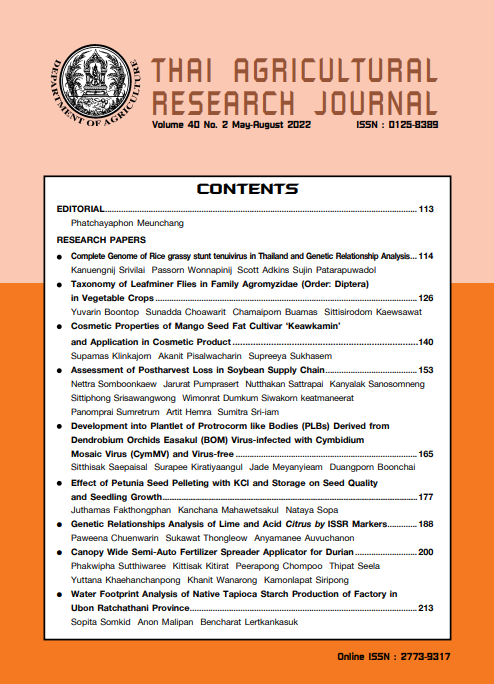Assessment of Postharvest Loss in Soybean Supply Chain
DOI:
https://doi.org/10.14456/thaidoa-agres.2022.13Keywords:
cereal, critical point, food loss, supply chain in Thailand, SDG 12.3.1Abstract
Soybean is one of important commodities in Thailand but information on losses and their causes is not up-to-date. The objective of this study was to identify the losses that occur in soybean supply chain, members in the chain and their roles in relation to losses, baseline of losses and critical points in the supply chain that causes losses. The obtained information was further used to reduce soybean losses in Thailand. The members in supply chain were in-depth interviewed, and soybeans samples were taken from each step in the supply chainforactual loss measurements.They werefrom the Provincesof Chiang Rai, Nan, Lampang, Chiang Mai, Mae Hong Son, Sukhothai, Nong Bua Lamphu, Udonthani and Khon Kaen in the 2020/2021 production year. Results showed that farmers play an important role invarious stepsof soybeansupplychaintogether withharvestor,collectorandentrepreneurs. The average loss of soybean (from actual measurements) throughout the supply chain was 34.1% whichcouldbedividedinto9.7% lossesatharvesting(harvestedbyhands1.91% and combine harvester 17.67%), threshing 6.38%, drying and storing at farmer’s house 7.79%, storage at collection point 5.63% and at raw material warehouse (before processing) 4.63%. Apparently, harvesting especially by machine caused the most loss, followed by improper storage and threshing. Thus, developing suitable method and equipment for soybean harvesting, threshing, and storage are essential to decrease the soybean losses in Thailand
References
กรรณิการ์ เพ็งคุ้ม. 2564. รายงานการวิจัยฉบับสมบูรณ์เรื่องการประเมินความสูญเสียอาหารผลิตภัณฑ์กล้วยและถั่วเขียวเพื่อหามาตรการลดความสูญเสียโดยตลอดห่วงโซ่คุณค่าและรายงานผลตามเป้าหมายการพัฒนาอย่างยั่งยืน ข้อที่ 12.3.1. สำนักงานพัฒนาการวิจัยการเกษตร (องค์การมหาชน). 171 หน้า.
กัณทิมา ทองศรี นรีลักษณ์ วรรณสาย นิภาภรณ์ พรรณรา สุดารัตน์ โชคแสน สนอง บัวเกตุ และ รวีวรรณ เชื้อกิตติศักดิ์. 2558. รายงานผลงานเรื่องเต็มการทดลองสิ้นสุดเรื่องการศึกษาอายุการเก็บเกี่ยวและวิธีการเก็บเกี่ยวที่มีผลต่อผลผลิตและคุณภาพเมล็ดพันธุ์ถั่วเหลือง. กรมวิชาการเกษตร. กรุงเทพฯ. 12 หน้า. แหล่งข้อมูล https://www.doa.go.th/research/attachment.php?aid=2329 สืบค้น: 12 มิถุนายน 2564.
คณะกรรมการอาหารแห่งชาติ. ม.ป.ป. กรอบยุทธศาสตร์การจัดการด้านอาหารของประเทศไทย. กรุงเทพฯ. 118 หน้า.
จารุรัตน์ พุ่มประเสริฐ และ จารุวรรณ บางแวก. 2564. การสูญเสียด้านปริมาณและคุณภาพของถั่วเหลือง. หน้า 80-84. ใน รายงานผลงานวิจัยเรื่องเต็มประจำปี 2563 เล่ม 1. กองวิจัยและพัฒนาวิทยาการหลังการเก็บเกี่ยวและแปรรูปผลิตผลเกษตร. กรมวิชาการเกษตร. กรุงเทพฯ.
นิลุบล ทวีกุล และ ละอองดาว แสงหล้า. 2547. วิทยาการก่อนและหลังการเก็บเกี่ยวถั่วเหลือง. เอกสารวิชาการลำดับที่ 10/2547 สถาบันวิจัยพืชไร่ กรมวิชาการเกษตร, กรุงเทพฯ. 171 หน้า.
วิษณุ อรรถวานิช โสมสกาว เพชรานนท์ ประพิณวดี ศิริศุภลักษณ์ อิสริยา นิติทัณฑ์ประภาศ บุญญะศิริ สมหมาย อุดมวิทิต อารียา โอบิเดียกรู และสุวพร ผาสุก. 2562. การศึกษาการสูญเสียอาหารในภาคการผลิตทางการเกษตรของประเทศไทย (เล่มที่ 1). สำนักงานพัฒนาการวิจัยการเกษตร (องค์การมหาชน), กรุงเทพฯ. 114 หน้า.
วุฒิพล จันทร์สระคู วรรธนะ สมนึก ภิรมย์ แถวเพีย เอกภาพ ป้านภูมิ มงคล ตุ่นเฮ้า และ สิทธิพงศ์ ศรีสว่างวงศ์. 2564. การพัฒนาเครื่องเกี่ยวนวดถั่วเหลืองแบบติดตั้งกับรถแทรกเตอร์ขนาดเล็ก. ว.วิชาการเกษตร. 39(3): 260-272.
สุวรรณ แซ่ซื้อ. 2542. ผลกระทบของเครื่องเก็บเกี่ยวถั่วเหลืองแบบวางรายต่อการสูญเสียผลผลิตถั่วเหลืองพันธุ์เชียงใหม่ 60. วิทยานิพนธ์วิทยาศาสตร์มหาบัณฑิต (สาขาวิทยาการหลังการเก็บเกี่ยว)มหาวิทยาลัยเชียงใหม่. 87 หน้า.
สำนักงานพัฒนาการวิจัยการเกษตร ม.ป.ป. Food loss study to boost up food security. กรุงเทพฯ. 53 หน้า.
สำนักงานเศรษฐกิจการเกษตร. 2564. ถั่วเหลือง: ร้อยละและปริมาณผลผลิตรายเดือนถั่วเหลือง รายจังหวัด ปีเพาะปลูก 2562/63. แหล่งข้อมูล: https://www.oae.go.th/assets/portals/1/fileups/ prcaidata/files/percent%20product%2062(4).pdf. สืบค้น: 5 กุมภาพันธ์ 2564.
สำนักงานเศรษฐกิจการเกษตร. 2565. ปริมาณการนำเข้าส่งออกถั่วเหลือง ปี 2563. แหล่งข้อมูล: mis-app.oae.go.th/product/ถั่วเหลือง. สืบค้น: 5 มีนาคม 2565.
FAO. 2018. SDG 12.3.1: Global food loss index methodology for monitoring SDG target 12.3. as approved by the interagency and expert group on sgd indicators, 6 november 2018 the global food loss index design, data collection methods and challenges. Available at: SDG 12.3.1 Global FLI_FAO Guideline.pdf. Accessed: 20 January 2021.
Filassi, M., L.A.R. Oliverira, A.A. Elias and K.B. Marsola. 2021. Analyzing complexities in the Brazilian soybean supply chain: a systems thinking and modeling approach. Available at: https://www.emerald.com/insight/2531-0488.htm. Accessed: 20 December 2021.
Ishangulyyev, R., S. Kim and S. Lee. 2019. Understanding food loss and waste—why are we losing and wasting food?. Foods. 8(8): 297.
Mores, G., R.B.T. Giehl, B.R. Kawano and H. Dewes. 2015. Food supply chain losses and waste: what are the challenges for the Brazilian soybean industry?. IFAMA 25th Annual World Conference: Become the Solution - Food Security. Available at: https://www.researchgate.net/publication/280805026_Food_supply_chain_losses_and_waste_what_are_the_challenges_for_the_Brazilian_soybean_industry. Accessed: 7 August 2021
Office of Agricultural Economics. n.d. The Study of Soybean Supply Chain in Chiang Mai Thailand. Bangkok. 132 p.
Downloads
Published
How to Cite
Issue
Section
License
Copyright (c) 2022 Thai Agricultural Research Journal

This work is licensed under a Creative Commons Attribution-NonCommercial-NoDerivatives 4.0 International License.
Thai Agricultural Research Journal



